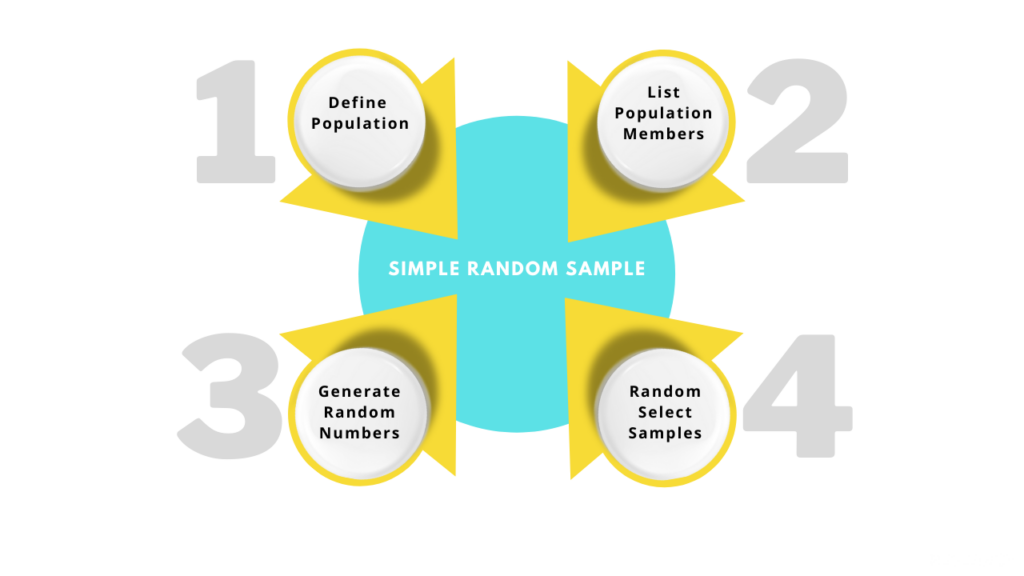Simple random sampling is the most common type of sampling strategy used in statistics, where a simple random sample represents a subset of individuals randomly picked from a larger population.
The simple random sampling approach is most widely used because random nonsystematic rules decide who will end up in the sample.
Consequently, the chance of the sample representing the population remains the same even if the population size changes [increases or decreases] in the future.
If this sounds confusing, don’t worry! In this tutorial, we will learn step-by-step how to conduct a simple random sampling using clear instructions and examples.
What Is Simple Random Sampling?
In simple random sampling, each member of the population has an independent and equal chance of being selected. Pay extra attention to the words independent and equal.

Independent because choosing one person does not skew [bias] the research results in favor of or against another person, and equal because there is no bias that a person will be chosen in favor of another.
When a random sample is taken, the characteristics of the sample should be extremely similar to those of the population being studied.
For example, if you were to select every tenth name from a phone book as your sample, would this be considered simple random sampling?
No, because the conditions of equality and independence in our example are being breached.
What if you open the phone book on page 145 and start sampling every tenth name onward?
Again no, because the names 2, 53, 82, 144, etc., never stand any equal chance of being selected. And once again, this strategy fails the test of independence.
But how to make sure that our sampling strategy meets the requirements for random sampling?
Let’s discuss this in the next section.
How To Take A Simple Random Sample
The process of simple random sampling consists of 4 essential steps to ensure it meets the criteria of being equal and independent.

Step 1: Define the Population
Define the population from which you want to randomly select the sample. For instance, your population can be based on age, gender, income, profession, etc.
If you plan to research the impact of gender on leadership style in an organization, your population is defined by the number of members both male and female that hold executive positions in that respective organization.
If you are looking to analyze the impact of social media on Generation Z’s socializing skills, your population will consist of individuals born between 1997 and 2012.
Think of a research population similar you would refer to the population of a country. There are plenty of statistics websites (e.g., Statista) where you can extract information about the population you plan to target in your study.
Step2: List the Population Members
Prepare a list containing all the members of the population targeted in your research. For instance, below is a group of 50 names representing the population for a hypothetical study.
NOTE: Populations are usually much larger. Table 1 below is used for illustrative purposes only, and all names were introduced in a random fashion.
| Nona | Louise | Dennis | Marilyn | Fred |
| Louis | Ernest | Joan | Bruce | Stephanie |
| Heather | James | Steve | Stephen | Rebecca |
| Harry | Helen | Nicholas | Ruby | Jeremy |
| Billy | Jerry | Natcha | Leo | Jimmy |
| Peter | Patricia | Alice | Donna | Michael |
| Christina | Joshua | Sara | Douglas | Arthur |
| Emily | Sean | Anna | Judith | Gloria |
| Catherine | Judy | Christopher | Russell | Matthew |
| Sara | Paul | Debora | Brandon | Terry |
Next, assign a number to each member of the population, as shown in Table 2 below. You will see in a moment why.
| 1. Nona | 11. Louise | 21. Dennis | 31. Marilyn | 41. Fred |
| 2. Louis | 12. Ernest | 22. Joan | 32. Bruce | 42. Stephanie |
| 3. Heather | 13. James | 23. Steve | 33. Stephen | 43. Rebecca |
| 4. Harry | 14. Helen | 24. Nicholas | 34. Ruby | 44. Jeremy |
| 5. Billy | 15. Jerry | 25. Natcha | 35. Leo | 45. Jimmy |
| 6. Peter | 16. Patricia | 26. Alice | 36. Donna | 46. Michael |
| 7. Christina | 17. Joshua | 27. Brandon | 37. Douglas | 47. Arthur |
| 8. Emily | 18. Sean | 28. Anna | 38. Judith | 48. Gloria |
| 9. Catherine | 19. Judy | 29. Christopher | 39. Russell | 49. Matthew |
| 10. Sara | 20. Paul | 30. Debora | 40. Sara | 50. Terry |
Step 3: Generate Random Numbers Table
Next, generate a table of random numbers. This is a great criterion because the numbers generated are totally unbiased.
For instance, in Table 3 below, the frequency of 1s, 2s, 3s, etc., is nearly even. Therefore, the likelihood of selecting any number between 01 to 50 is high. Since we already assigned numbers to names, too, this likelihood applies to the names as well.
To generate a random number table, you can use any data analysis tool such as Microsoft® Excel, Google® Sheets, or IBM® SPSS.
Here is a quick guide on How To Generate Random Numbers In Excel if you don’t know how to do that.
| 77639 | 32979 | 73301 | 68885 | 50600 |
| 30908 | 87023 | 33398 | 39372 | 91302 |
| 34648 | 94087 | 85873 | 71806 | 55956 |
| 75493 | 48440 | 26548 | 61651 | 57530 |
| 94314 | 60351 | 67168 | 26103 | 55266 |
| 37716 | 74520 | 27723 | 67779 | 86469 |
| 66742 | 45432 | 87145 | 67060 | 35561 |
| 46013 | 24938 | 75270 | 72717 | 17987 |
| 12462 | 24108 | 82450 | 91907 | 46432 |
| 46555 | 94587 | 40788 | 51337 | 49094 |
Step 4: Select A Simple Random Sample
Let’s assume that our sample size consists of ten individuals. To select a simple random sample from the given population, do as follows:
Select a starting point by closing your eyes and pointing your finger [or pen] anywhere on the table [Table 3]. In this way, we make sure no bias is used to select the starting point [or name].
For instance, the first number I selected is 94087 located in the second column, third row as shown below.
| 77639 | 32979 | 73301 | 68885 | 50600 |
| 30908 | 87023 | 33398 | 39372 | 91302 |
| 34648 | 94087 | 85873 | 71806 | 55956 |
| 75493 | 48440 | 26548 | 61651 | 57530 |
| 94314 | 60351 | 67168 | 26103 | 55266 |
| 37716 | 74520 | 27723 | 67779 | 86469 |
| 66742 | 45432 | 87145 | 67060 | 35561 |
| 46013 | 24938 | 75270 | 72717 | 17987 |
| 12462 | 24108 | 82450 | 91907 | 46432 |
| 46555 | 94586 | 40788 | 51337 | 49094 |
Oops, we have an issue! The 94087 number ends with 87, and 87 is outside the total range of our population – which is 50. In this case, we can use the next two digits in the same number, which is 40. Success!
The number 40 is assigned to the name Sara [Table 2]. Therefore Sara is the first member of our simple random sample using chance.
Now repeat the same process until the requirements for your sample size are met. Here is my simple random sample selection using the method explained so far.
| 77639 | 32979 | 73301 | 68885 | 50633 |
| 30908 | 87023 | 31398 | 39372 | 91302 |
| 34648 | 94087 | 85873 | 71806 | 55956 |
| 75493 | 48409 | 26548 | 61651 | 57530 |
| 94314 | 60351 | 67168 | 26103 | 55266 |
| 37716 | 74520 | 27723 | 67779 | 86469 |
| 66742 | 45432 | 87145 | 67060 | 35561 |
| 46013 | 24938 | 75270 | 72717 | 17987 |
| 12462 | 24108 | 82450 | 91907 | 46432 |
| 46555 | 94587 | 40788 | 51337 | 49094 |
Next, create a table with the numbers and their respective name assigned in Step 3. Here is my table using the simple random sampling procedure in the order of random selection.
| Number | Name |
| 40 | Sara |
| 14 | Helen |
| 09 | Catherine |
| 33 | Stephen |
| 13 | James |
| 46 | Michael |
| 39 | Russell |
| 16 | Patricia |
| 45 | Jimmy |
| 38 | Judith |
Here you go. You now have a sample of 10 names from a population of 50 selected entirely by chance. Remember that the probability of any of the names selected applies to all the other names in the population.
Our sample is selected by chance because the randomly generated numbers in our table were produced by chance.
Also, note that the names in Table 1 were introduced in the table in a random fashion. In other words, we did not insert the 01-30 names because they are coming from the same city, company, or based on income or status. In this way, we avoid any peculiarity that might impact an unbiased selection.
Conclusion
Simple random sampling is a technique for selecting a smaller sample size from a population to conduct research and draw generalizations about it.
The simplicity of usage and accurate representation of the broader population are two benefits of a simple random sample.
Cite this article in your research paper:
[citationic]

